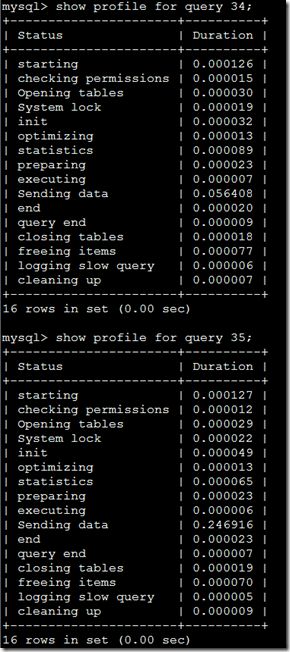记录mysql性能查询过程
一切源于一个实验,请看下面的例子:
表:
CREATE TABLE IF NOT EXISTS `foo` ( `a` int(10) unsigned NOT NULL AUTO_INCREMENT, `b` int(10) unsigned NOT NULL, `c` varchar(100) NOT NULL, PRIMARY KEY (`a`), KEY `bar` (`b`,`a`) ) ENGINE=InnoDB; CREATE TABLE IF NOT EXISTS `foo2` ( `a` int(10) unsigned NOT NULL AUTO_INCREMENT, `b` int(10) unsigned NOT NULL, `c` varchar(100) NOT NULL, PRIMARY KEY (`a`), KEY `bar` (`b`,`a`) ) ENGINE=MyISAM;
我往两个表中插入了30w的数据(插入的时候性能差别InnoDB比MyISAM慢)
<?php
$host = '192.168.100.166';
$dbName = 'test';
$user = 'root';
$password = '';
$db = mysql_connect($host, $user, $password) or die('DB connect failed');
mysql_select_db($dbName, $db);
echo '===================InnoDB=======================' . "\r\n";
$start = microtime(true);
mysql_query("SELECT SQL_NO_CACHE SQL_CALC_FOUND_ROWS * FROM foo WHERE b = 1 LIMIT 1000, 10");
$end = microtime(true);
echo $end - $start . "\r\n";
echo '===================MyISAM=======================' . "\r\n";
$start = microtime(true);
mysql_query("SELECT SQL_NO_CACHE SQL_CALC_FOUND_ROWS * FROM foo2 WHERE b = 1 LIMIT 1000, 10");
$end = microtime(true);
echo $end - $start . "\r\n";
返回结果:
一次查询就会差别这么多!!InnoDB和MyISAM,赶紧分析分析为什么。
首先是使用explain来进行查看
确定两边都没有使用index,第二个查询查的rows,并且MyISAM的查询rows还比InnoDB少这么多,反而是查询慢于InnoDB!!这Y的有点奇怪。
没事,还有一个牛掰工具profile
具体使用可以参考:http://dev.mysql.com/doc/refman/5.0/en/show-profile.html
使用方法简单来说:
Mysql > set profiling = 1; Mysql>show profiles; Mysql>show profile for query 1;
这个数据中就可以看到MyISAM的Sending data比InnoDB的Sending data费时太多了。查看mysql文档
http://dev.mysql.com/doc/refman/5.0/en/general-thread-states.html
Sending data
The thread is reading and processing rows for a SELECT statement, and sending data to the client. Because operations occurring during this this state tend to perform large amounts of disk access (reads), it is often the longest-running state over the lifetime of a given query.
Sending data是去磁盘中读取select的结果,然后将结果返回给客户端。这个过程会有大量的IO操作。你可以使用show profile cpu for query XX;来进行查看,发现MyISAM的CPU_system比InnnoDB大很多。至此可以得出结论是MyISAM进行表查询(区别仅仅使用索引就可以完成的查询)比InnoDB慢。
至于再往下的为什么,我想就需要看源码了..于是,就此打住。
附带一篇文章,里面还有status的用法
http://hi.baidu.com/thinkinginlamp/item/8d038333c6b0674a3075a1d3
参考文章:
http://dev.mysql.com/doc/refman/5.0/en/show-profile.html
http://stackoverflow.com/questions/6274891/mysql-innodb-count-vs-counting-rows-on-server-side
http://www.yqshare.com/mysql-sql-show-profile.html
http://stackoverflow.com/questions/3638624/mysql-profiler-sending-data
http://hi.baidu.com/hexie007/item/126939785b86353c714423cd
http://moonbingbing.blogspot.com/2010/12/mysql-profilesending-data.html


